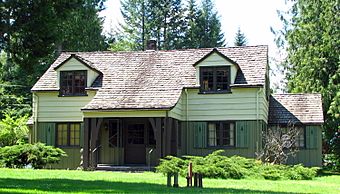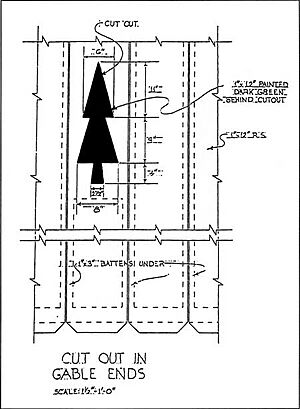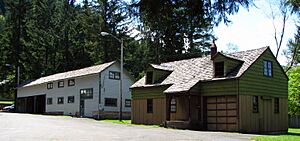Zigzag Ranger Station facts for kids
Quick facts for kids |
|
|
Zigzag Ranger Station
|
|

Zigzag District Office
|
|
| Location | Mount Hood National Forest |
|---|---|
| Nearest city | Zigzag, Oregon, USA |
| Built | 1935 |
| Architectural style | Cascadian rustic |
| NRHP reference No. | 86000842 |
| Added to NRHP | 1986 |
The Zigzag Ranger Station is a special place in Oregon's beautiful Mount Hood National Forest. It's a group of twenty old-fashioned, rustic buildings used by the Forest Service. This station was built to be the main office for the Zigzag area. You can find it in the small town of Zigzag, Oregon. Many of these historic buildings were put up by the Civilian Conservation Corps (CCC) between 1933 and 1942. Even today, the Forest Service still uses the Zigzag Ranger Station as its main office for the district. This important station is listed on the National Register of Historic Places.
Contents
Discover the Zigzag Ranger Station's Past
In the early 1900s, forest roads were not very good. To help people work in the National Forests, the Forest Service built ranger stations. These stations were placed in key spots to house workers. They also helped fire patrols and project teams working far away in the forest.
After World War II, the Forest Service built many more roads. This made it easier for workers to reach most forest areas quickly. Because of this, many isolated ranger stations closed. Others became summer-only stations. However, the Zigzag Ranger Station has always been a district headquarters since it was built.
How the Ranger Station Grew
In 1908, the Forest Service created the Oregon National Forest. This forest was around Mount Hood in northern Oregon. The very first Forest Service building at the Zigzag site was built in 1917. Several more buildings were added to the area in the 1920s.
In 1924, a large part of the Oregon National Forest became the Mount Hood National Forest. This included the Zigzag Ranger District. In 1933, the Civilian Conservation Corps (CCC) began building at the ranger station.
Civilian Conservation Corps Builds History
Between 1933 and 1942, CCC crews built nine buildings at the ranger station. The CCC workers came from a nearby place called Camp Zigzag. They worked under the guidance of Forest Service rangers. All the buildings from this time were designed by the Forest Service's Pacific Northwest team. They were built in a style called "Cascadian rustic."
Today, the ranger station still serves as the main office for the Zigzag Ranger District. There are twenty buildings in the complex. Nineteen of these buildings, plus a stone wall built by the CCC, are historically important. All the old buildings are still used and are in great shape. The Zigzag Ranger Station is very special because it's an early Forest Service station. Because of this, the station and the land around it were added to the National Register of Historic Places on April 8, 1986. The historic area covers about 125 acres (0.51 km2).
Explore the Historic Buildings
With nineteen historic buildings, the Zigzag Ranger Station is a classic Forest Service station. Nine of these historic buildings were built by the Civilian Conservation Corps (CCC) between 1933 and 1942.
Their work included:
- a district administrative office
- homes for rangers
- a crew bunkhouse
- a fire equipment warehouse
- two warehouses for road and trail equipment
- a carpenter shop
- a garage
- a gas house
The buildings were made in the Cascadian rustic style. They used materials like weatherboard, wood shingles, local stone, and concrete. Many of the roof ends (gables) and window covers (shutters) have the open pine tree logo. This logo was common on Forest Service buildings from the 1930s. The CCC also built stone walls at the ranger station.
Key Buildings at Zigzag Ranger Station
- The Ranger's Office is a two-story building. It is about 53 feet (16 m) wide and 41 feet (12 m) long. It has a pointed roof with a stone chimney. There are windows that stick out from the roof (dormers) on each side. The bottom half of the office has vertical boards. The top half has horizontal boards. The front and back porches have large support posts and stone floors.
- The Ranger's Residence is a rectangular house with a stone base and a pointed roof. The roof ends have vertical boards with open pine tree logos cut into them. The front porch has square support posts. Next to the house is a matching Garage with the same siding and tree logos. In 2007, the Forest Service replaced the old wood roofs on both buildings with new, heavy wood shingles.
- The large two-story Bunkhouse was also a home for assistant rangers. Like the office, the bunkhouse has vertical boards on its lower level. It has horizontal boards on the upper half. There is a concrete foundation in the front to make the house level on slightly sloped ground. The front porch is not in the center. There is also a side porch with a roof that hangs over. Both porches have large support posts with curved wooden braces.
- Like the office and bunkhouse, the Fire Warehouse is a two-story building. It has vertical boards on its lower half and horizontal boards on the upper half. It has a pointed roof with four dormer windows. The front porch has 10-inch (250 mm) square posts. There is a garage door on the right side. There is also a second-floor entrance from an outside stairway.
- There are two Road and Trail Warehouse buildings. The first warehouse is a large rectangular building with horizontal siding and sliding garage doors. The second warehouse is a building with a saltbox roof. Both buildings are original, but they have been changed a bit over time.
- The Carpenter Shop is a long, rectangular building. It is about 80 feet (24 m) by 45 feet (14 m). The shop has a pointed roof with four dormer windows. The two ends of the roof stick out a little. There is vertical siding under these overhangs with Forest Service pine tree logo cutouts. The rest of the building has horizontal siding. There are large garage doors along the front of the building.
- The Gas House is a building with horizontal siding and a pointed roof. The roof structure is open at the ends. A large overhang protects the gas pumps and vehicle service area.
Wy'East Rhododendron Gardens
The Wy'East Rhododendron Gardens are located right on the grounds of the Zigzag Ranger Station. These gardens were started in 1952. The idea was to make the roadside more beautiful. Local nurseries and individual gardeners gave 100 plants to begin the garden. When it officially opened on May 24, 1953, the garden had grown to 235 rhododendron plants! James P. Langdon, who was the Zigzag District Ranger at the time, gave more trees and shrubs from his own nursery. These plants, like the rare Dawn Redwood, helped make the gardens even better.
Not all the first plants survived. However, the Wy'East Rhododendron Gardens still have 50 different types of rhododendrons. They also have over 150 other plants. The gardens are a great place to see many trees and shrubs that grow naturally in the Mount Hood National Forest. You can also find many plants that are not native to the area. The gardens are open all year for you to walk around and explore. A map of the garden, showing where to find all 50 rhododendron types, is available at the Zigzag district office.
Where is the Zigzag Ranger Station?
The Zigzag Ranger Station is in eastern Clackamas County, Oregon. It is surrounded by the beautiful Mount Hood National Forest. The station is about 1,460 feet (445 m) above sea level. The forest around the station has trees like Douglas fir, Western red cedar, big leaf maple, vine maple, red alder, cascara buckthorn, and Pacific dogwood.
The Zigzag Ranger Station is about 45 miles (72 km) east of Portland, Oregon. It is in the small town of Zigzag. The ranger station is just off U.S. Highway 26. The station has buildings on both sides of the highway. However, the main office and most of the historic buildings are on the south side of the highway. This is also where you will find the Wy'East Rhododendron Gardens.



